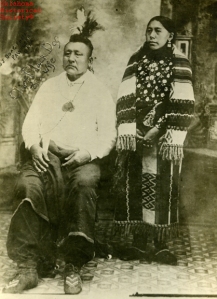
Chief Black Dog-II with Wife
Although there have been many Osage Chiefs over the history of the people, I will probably continue to return to Chief Black Dog and his band of Osage, as he was paramount to the local history in this area where Missouri, Kansas and Oklahoma meet.
Black Dog was a huge man, even by today’s standards. He stood 7 feet tall and was well over 300 pounds by all accounts. I will not attempt to go into a personal history of the Chief at this time. Native American history can be confusing at best. Each person may have been known by several names, for instance, an ‘honor name’ which is something to be earned in battle or hunting. (War and hunting were practically the same for their purposes). Besides having multiple names, there are generations carrying the same name. At this time I am speaking of Black Dog I and his accomplishments in primitive civil engineering. There are 3 main feats to mention.
Although Black Dog’s Band lived in Missouri, Kansas and Oklahoma, the Black Dog Trail extended across southern Kansas. It went from Baxter Springs to Cedar Vale, to Hooser, up to Dexter, to Silver Creek, near Winfield and across to the Arkansas River north of Oxford. An 1895 map supports this account and today’s US highway 166 runs on the same route in many places. This major trail also had many alternate routes, as do all of the ancient Osage trails. The main trail was completely cleared of rocks and plants. One account says that in most places the trail was “eight horses wide”. Black Dog I is correctly credited with creating the very first improved roads in both Kansas and Oklahoma.



Pingback: Hyper Trails Mix too « Sitting Pugs: Sports Movies
What evidence do you have that scouts from this band had anything to do with Custer. While I know there were approximately 2-3 Osage scouts who served with Custer for a short period, that hardly means an entire people were not innocent. To my knowledge there are no records existing which held records of who lived amongst which village. There were many Osage villages at this time which all stem from the original 5 bands. Your ending remark makes about as much sense as me saying I guess since Charles Manson was white all white people are not innocent? very poor ending to an otherwise well written article.